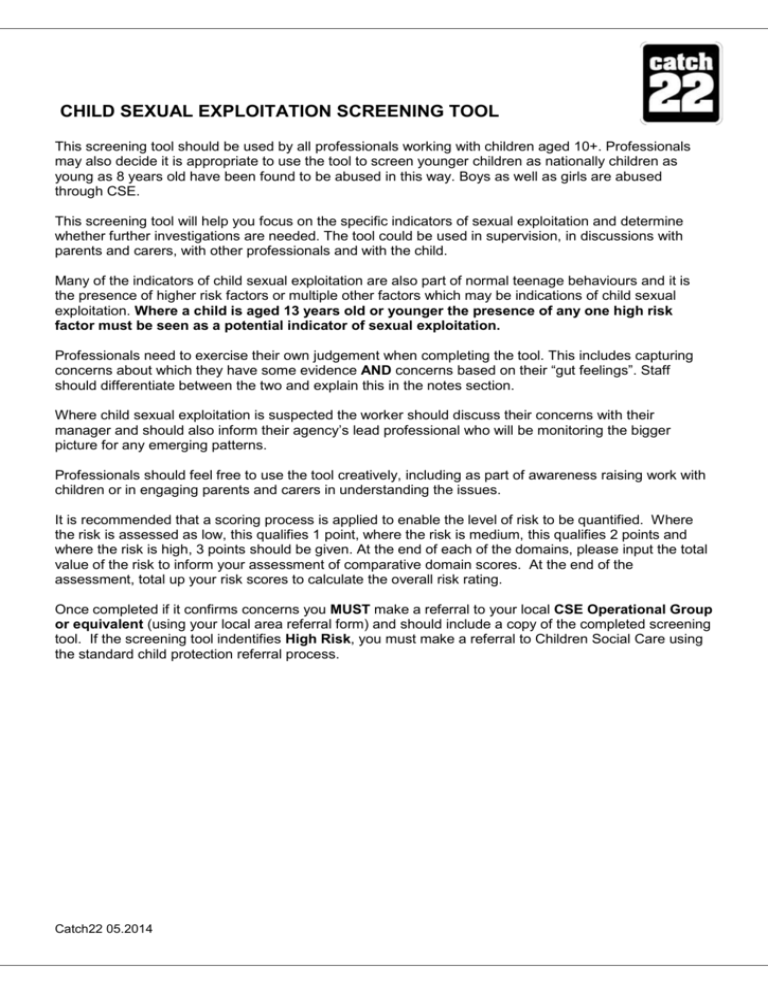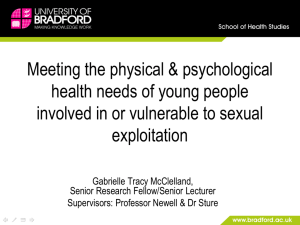Catch 22 CSE Screening Tool
advertisement

CHILD SEXUAL EXPLOITATION SCREENING TOOL This screening tool should be used by all professionals working with children aged 10+. Professionals may also decide it is appropriate to use the tool to screen younger children as nationally children as young as 8 years old have been found to be abused in this way. Boys as well as girls are abused through CSE. This screening tool will help you focus on the specific indicators of sexual exploitation and determine whether further investigations are needed. The tool could be used in supervision, in discussions with parents and carers, with other professionals and with the child. Many of the indicators of child sexual exploitation are also part of normal teenage behaviours and it is the presence of higher risk factors or multiple other factors which may be indications of child sexual exploitation. Where a child is aged 13 years old or younger the presence of any one high risk factor must be seen as a potential indicator of sexual exploitation. Professionals need to exercise their own judgement when completing the tool. This includes capturing concerns about which they have some evidence AND concerns based on their “gut feelings”. Staff should differentiate between the two and explain this in the notes section. Where child sexual exploitation is suspected the worker should discuss their concerns with their manager and should also inform their agency’s lead professional who will be monitoring the bigger picture for any emerging patterns. Professionals should feel free to use the tool creatively, including as part of awareness raising work with children or in engaging parents and carers in understanding the issues. It is recommended that a scoring process is applied to enable the level of risk to be quantified. Where the risk is assessed as low, this qualifies 1 point, where the risk is medium, this qualifies 2 points and where the risk is high, 3 points should be given. At the end of each of the domains, please input the total value of the risk to inform your assessment of comparative domain scores. At the end of the assessment, total up your risk scores to calculate the overall risk rating. Once completed if it confirms concerns you MUST make a referral to your local CSE Operational Group or equivalent (using your local area referral form) and should include a copy of the completed screening tool. If the screening tool indentifies High Risk, you must make a referral to Children Social Care using the standard child protection referral process. Catch22 05.2014 Child’s Name: Dob: Name and job title of person completing: Date completed: Organisation: Contact e-mail: Telephone: When completing the screening tool you must use your own judgement as factors such as the child’s age, any additional vulnerabilities, their history, etc, may mean that what for another child would be low level, for that child is high level. Workers should feel free to amend the suggested level using that judgement. You can either indicate the level of risk using High/medium/low or simply tick the box if the risk element is present (you may wish to use more ticks where the risk is higher. Remember, this tool is to help you make a professional assessment and you should not feel constrained by the format. Record your rationale in the notes boxes. Health Domain Present? Yes/No/Possible. Please comment: Risk Rating 1=L, 2=M, 3=H Physical injuries such as bruising, suggesting of either physical or sexual assault A sexually transmitted infection (STI), particularly if it is recurring or there are multiple STI’s Pregnancy and / or seeking an abortion Sexually risky behaviour Self-harming Thoughts of or attempted suicide Eating disorder Evidence of misuse of drugs / alcohol, including associated health problems Change in appearance, including losing weight, putting on weight Learning Disability TOTAL HEALTH RISK: Behaviour Domain Sexually offending behaviour Truancy/disengagement with education or considerable change in performance at school Volatile behaviour, exhibiting extreme array of mood swings or abusive language which is unusual for the child Aggressive or violent, including to pets/animals Catch22 05.2014 Present? Yes/No/Possible. Please comment: Risk Rating 1=L, 2=M, 3=H Becoming angry/ hostile if any suspicions or concerns about their activities are expressed Physical aggression towards parents, siblings, pets, teachers or peers Detachment from age-appropriate activities Secretive behaviour Known to be sexually active Low self-image, low self-esteem Young offender or anti-social behaviour Sexualised language Hostility in relationship with parents / carers and other family members Getting involved in petty crime such as shoplifting or stealing TOTAL BEHAVIOUR RISK: Grooming Domain Entering or leaving vehicles driven by unknown adults Excessive use of mobile phones, including receiving calls late at night Reports that the child/young person has been seen in places known to be used for sexual exploitation Unexplained relationships with older adults Associating with other young people who are known to be sexually exploited, including in school Sexual relationship with a significantly older person Phone calls, texts or letters from unknown adults Mobile phone being answered by unknown adult Inappropriate use of the Internet and forming relationships, particularly with adults, via the Internet. Note: adults may pose as peers to entrap the child Accounts of social activities with no plausible explanation of the source of necessary funding Having keys to premises other than those they should have Possession of money with no plausible explanation Acquisition of expensive or sexual clothes, mobile phone or other possession without plausible explanation Having new mobile phone, several mobile phones and/or SIM cards, especially Blackberry or iPhone Catch22 05.2014 Present? Yes/No/Possible. Please comment: Risk Rating 1=L, 2=M, 3=H (because messages cannot be traced). Always have credit on their mobile phones, despite having no access to money or having no credit so phone can only be used for incoming calls Recruiting others into sexual exploitation Seen at public toilets known for cottaging or adult venues (pubs and clubs) Adults loitering outside the child/young person’s usual place of residence or school Leaving home/care setting in clothing unusual for the individual child (inappropriate for age, borrowing clothes from older young people) Wearing an unusual amount of clothing (due to hiding more sexualised clothing underneath or hiding their body) Persistently missing, staying out overnight or returning late with no plausible explanation Returning after having been missing, looking well cared for in spite of having no known home base Returning after having been missing looking dirty, dishevelled, tired, hungry, thirsty Missing for long periods with no known home base and / or homeless Possession of excessive numbers of condoms New contacts with people outside of town TOTAL GROOMING RISK: Looked After Children Domain Present? Yes/No/Possible. Please comment: Risk Rating 1=L, 2=M, 3=H Living in residential care Frequently missing from placement Multiple placement breakdown Going missing with other children TOTAL LOOKED AFTER CHILD RISK: Family and Social Domain A family member or known associate working in the adult sex trade Unsure about their sexual orientation or unable to disclose sexual orientation to their family History of physical, sexual and/or emotional abuse; neglect Catch22 05.2014 Present? Yes/No/Possible. Please comment: Risk Rating 1=L, 2=M, 3=H Witness to domestic violence at home Parental difficulties; drug and alcohol misuse; mental health problems; physical or learning difficulty. Being a young carer Pattern of street homelessness or sofa surfing Living in hostel, B&B or Foyer accommodation Conflict at home around boundaries, including staying out late Recent bereavement or loss Gang association either through relatives, peers or intimate relationships Lacking friends their own age Living in a gang neighbourhood TOTAL FAMILY AND SOCIAL RISK: E Safety Domain Evidence of sexual bullying and/or vulnerability through Internet or social networking sites Concern that inappropriate images of a young person are being circulated via the Internet/phones Exchanging inappropriate images for cash, credits or other items Receiving gifts through the post from someone the young person does not known Concern that a young person is being coerced to provide sexually explicit images Concern that a young person is being bribed by someone for their inappropriate online activity Concern that a young person is selling sexual services via the Internet Accessing dating agencies via mobile phones (eg 2 flirt line) Unexplained increased mobile phone / gaming credits Going online during the night Being secretive, using mobile phone for accessing websites, etc, more than computers Unwilling to share / show online or phone contacts Concerns that a young person’s online friendship has developed into an offline relationship Concern that a young person is having an online relationship Sharing of inappropriate images Catch22 05.2014 Present? Yes/No/Possible. Please comment: Risk Rating 1=L, 2=M, 3=H amongst friends New contacts with people outside of town Increased time on webcam, especially if in bedroom Spending increasing amount of time with online friends and less time with friends from school or neighbourhood Spending increasing amount of time on social networking sites including Facebook or on shared gaming sites TOTAL SAFETY RISK: What is the level of risk for this child? Why? High ( 177 - 264) Medium (89 – 176) Low (0-88) In every case where sexual exploitation is a risk factor for a child (high, medium or low) you should refer the child to your local CSE Operational Group or equivalent using your local referral form and attaching the CSE screening tool. If professionals are still unsure of the level of risk once the form has been completed please, contact your line manager to talk through the assessment and outcome. Catch22 05.2014



